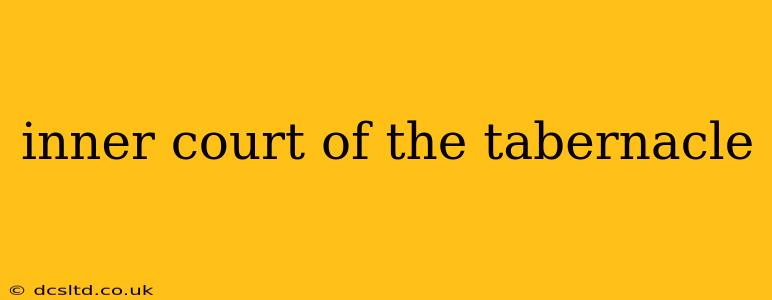The Tabernacle, the portable sanctuary of the Israelites during their wilderness wanderings, held profound religious significance. While the outer court served as a space for preparation and cleansing, the inner court, known as the Holy Place, was the heart of the Tabernacle, a sacred area reserved for the priests and their sacred duties. This article delves into the mysteries and significance of the Tabernacle's inner court, exploring its layout, furnishings, and symbolic meaning.
What was the Inner Court of the Tabernacle?
The inner court of the Tabernacle was a meticulously designed space, separated from the outer court by a richly embroidered curtain. Unlike the outer court, open to all Israelites, access to the Holy Place was strictly limited to the priests. This restriction underscored the sacredness and holiness of this area, which housed the essential elements for God's presence among His people. It was here that the priests performed the daily rituals, maintaining the connection between God and the Israelites.
What was inside the Holy Place?
The Holy Place contained three key pieces of furniture:
-
The Menorah (Lampstand): This seven-branched lampstand, made of pure gold, was perpetually lit, symbolizing the divine light and presence of God. Its constant flame represented God's unwavering faithfulness and enduring covenant with His people.
-
The Table of Showbread: This golden table held twelve loaves of bread, representing the twelve tribes of Israel. The bread was replaced weekly, a continuous offering symbolizing God's provision and sustenance for His people. It also served as a reminder of God's covenant and His constant presence.
-
The Altar of Incense: This golden altar was used to burn fragrant incense, a sweet-smelling offering that ascended to God as a prayer. The fragrant smoke served as a symbol of the prayers of the people rising to heaven.
What was the significance of the Inner Court?
The Holy Place’s significance stemmed from its role as the intermediary space between the outer court and the Holy of Holies. It served as a transition zone, symbolizing the journey from the everyday world to the sacred presence of God. The restricted access to this area highlighted the sanctity of God and the importance of proper preparation and reverence when approaching His presence. The rituals performed within the Holy Place served as a constant reminder of God's covenant and His ongoing relationship with His people.
What was the difference between the inner court and the outer court?
The primary difference between the inner and outer courts lay in their accessibility and purpose. The outer court was open to all Israelites, providing a place for ritual cleansing and preparation. The inner court, however, was exclusively for priests, emphasizing its sacred nature and the limited access to God's immediate presence. The outer court dealt with matters of cleansing and atonement for the people, while the inner court focused on maintaining the constant connection between God and His people through daily rituals.
What were the dimensions of the Inner Court?
The exact dimensions of the inner court are not explicitly stated in the biblical text, but we know from Exodus 26 that the Tabernacle itself was 30 cubits long, 10 cubits wide, and 10 cubits high. The inner court, being a section within the Tabernacle, would have been smaller, however the precise dimensions remain a matter of scholarly discussion and interpretation of ancient measurements.
What were the materials used in the construction of the Inner Court?
The inner court was not a separate structure but rather a designated area within the Tabernacle. Its construction primarily involved the finely woven curtain that separated it from the outer court, along with the carefully crafted furniture detailed above. The primary materials used were fine linen, gold, and precious metals, reflecting the sacred nature of the space and the divine presence it housed.
This exploration of the Tabernacle's inner court reveals a carefully crafted space designed for sacred interactions between God and His people. The layout, furnishings, and rituals performed within this space all contributed to its profound religious and symbolic importance. It served as a powerful representation of God's presence, covenant, and ongoing relationship with the Israelites.
